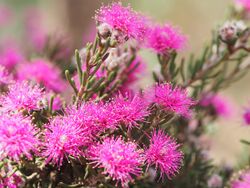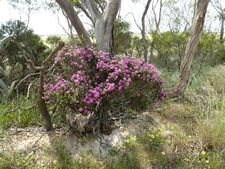Biology:Melaleuca plumea
| Melaleuca plumea | |
|---|---|

| |
| Scientific classification | |
| Kingdom: | Plantae |
| Clade: | Tracheophytes |
| Clade: | Angiosperms |
| Clade: | Eudicots |
| Clade: | Rosids |
| Order: | Myrtales |
| Family: | Myrtaceae |
| Genus: | Melaleuca |
| Species: | M. plumea
|
| Binomial name | |
| Melaleuca plumea Craven[1]
| |
Melaleuca plumea is a shrub in the myrtle family, Myrtaceae, and is endemic to the south of Western Australia. It is a widely spreading, densely foliaged shrub which produces masses of deep pink flowers in spring and early summer. Fluffy hairs on parts of the flowers, including the bracts covering the flower buds, are also a feature.
Description
Melaleuca plumea is a low, ground-hugging shrub growing to a height of 2 m (7 ft) and sometimes more than 3 m (10 ft) wide. The leaves are arranged alternately, 4.5–10.5 mm (0.2–0.4 in) long, 1.0–2.2 mm (0.04–0.09 in) wide, linear to narrow oval in shape, the end either round or with a short point.[2]
The flowers are a shade of pink or purple. They are arranged in heads near the ends of branches which continue to grow after flowering and also in some of the upper leaf axils. The flower buds are covered with brown bracts. The bracts, flower bases (hypanthia) and sepals are all covered with white fluff. Each head contains up to 5 groups of flowers in threes and is up to 17 mm (0.7 in) in diameter. The stamens, which give the flowers their colour, are arranged in 5 bundles around the flower, with 5 to 8 stamens in each bundle. The flowers mainly appear from September to December and are followed by fruit which are woody capsules 2.5–3.5 mm (0.1–0.1 in) long in clusters around the stem.[2][3]
Taxonomy and naming
Melaleuca plumea was first described in 1999 by Lyndley Craven in a review of the genus.[4][5] The specific epithet (plumea) is from the Latin plumeus meaning "downy"[6] referring to the woolly parts of the flowers.[2]
Distribution and habitat
This melaleuca occurs in and between the Salmon Gums, Scaddan and Mount Beaumont districts[2] in the Esperance Plains and Mallee biogeographic regions growing in sand or clay, on dune slopes and near salt lakes and river flats.[7]
Conservation
Melaleuca plumea is classified as "not threatened" by the Government of Western Australia Department of Parks and Wildlife.[7]
Essential oils
The leaves of this species contains mainly monoterpenes, especially 1,8-cineole (Eucalyptol).[2]
References
- ↑ "Melaleuca plumea". Plants of the World Online. https://powo.science.kew.org/taxon/urn:lsid:ipni.org:names:1011855-1.
- ↑ Jump up to: 2.0 2.1 2.2 2.3 2.4 Brophy, Joseph J.; Craven, Lyndley A.; Doran, John C. (2013). Melaleucas : their botany, essential oils and uses. Canberra: Australian Centre for International Agricultural Research. p. 285. ISBN 9781922137517.
- ↑ Holliday, Ivan (2004). Melaleucas : a field and garden guide (2nd ed.). Frenchs Forest, N.S.W.: Reed New Holland Publishers. pp. 218–219. ISBN 1876334983.
- ↑ "Melaleuca plumea". APNI. https://biodiversity.org.au/boa/instance/apni/561833. Retrieved 16 April 2015.
- ↑ Craven, L. A.; Lepschi, B. J. (1999). "Enumeration of the species and infraspecific taxa of Melaleuca (Myrtaceae) occurring in Australia and Tasmania". Australian Systematic Botany 12 (6): 916. doi:10.1071/SB98019. http://www.publish.csiro.au/paper/SB98019.htm. Retrieved 12 March 2015.
- ↑ Brown, Roland Wilbur (1956). The Composition of Scientific Words. Washington, D.C.: Smithsonian Institution Press. p. 322.
- ↑ Jump up to: 7.0 7.1 "Melaleuca plumea Craven". FloraBase. Western Australian Government Department of Parks and Wildlife. https://florabase.dpaw.wa.gov.au/browse/profile/19609.
Wikidata ☰ Q15372199 entry
 |


